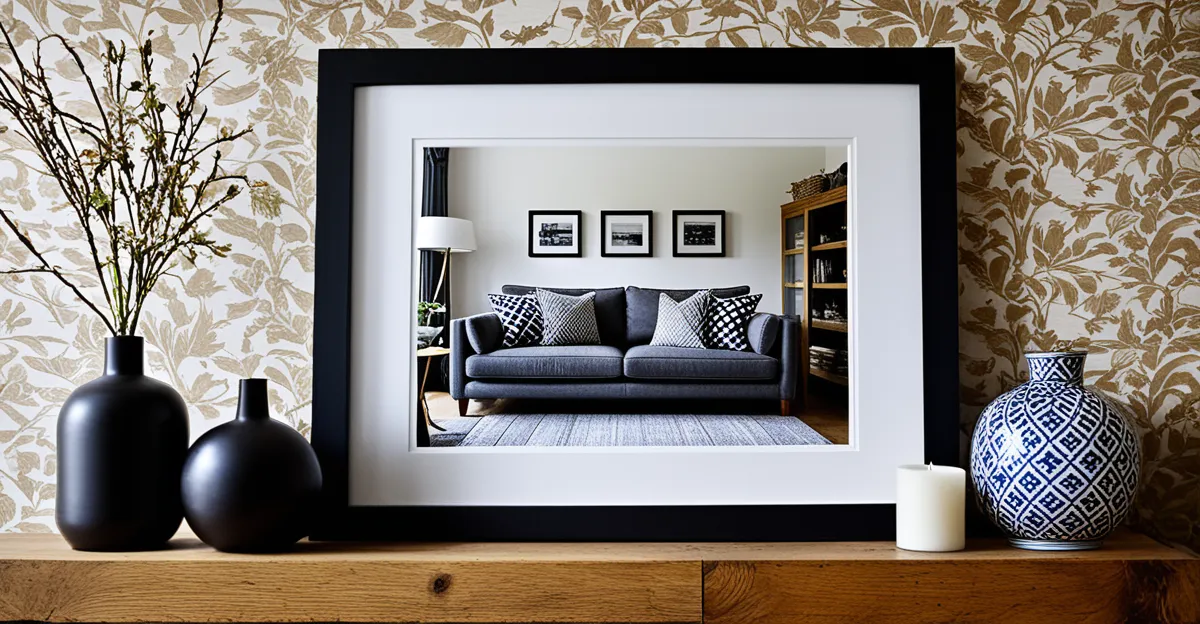Defining Characteristics of UK Home Decor
British interior design is known for its distinctive charm that blends tradition with contemporary influences. What sets UK home decor apart is its ability to combine an eclectic mix of styles while maintaining a sense of timelessness. This approach creates spaces that feel both lived-in and curated, reflecting a uniquely British sensibility.
A hallmark of UK home decor style is the use of curated details that showcase personality and history. These might include a mix of antique furnishings, modern art, and decorative objects collected over time. This eclecticism is not chaotic; rather, it is carefully balanced to ensure harmony. Additionally, British interiors often emphasize comfort and functionality alongside aesthetics.
Additional reading : What are the top DIY projects to enhance your UK home’s value?
The timeless aspect involves choosing pieces and décor elements that transcend passing trends. This could be classic patterned fabrics, rich textures, or traditional color palettes that echo the country’s historical influences. Such elements anchor the home and give it depth.
In summary, UK home decor style thrives on an artful combination of curated details, timeless pieces, and eclectic mixes, creating spaces that feel warm, inviting, and distinctly British.
Also to read : How Can You Enhance Your Home’s Curb Appeal Efficiently?
Influences Shaping British Interior Aesthetics
British interior design is deeply rooted in the UK cultural decor influences, drawing extensively from the nation’s rich heritage and historical context. Understanding how these factors shape British interiors helps clarify why UK home decor style is so distinctive.
One of the primary forces behind British interior aesthetics is the country’s historic British design legacy. Many British homes incorporate design elements that reflect centuries of architectural evolution—from the grandeur of Georgian and Victorian periods to the rustic charm of Tudor and country cottages. These heritage styles often feature detailed moldings, sash windows, and fireplaces, which provide a foundation for the overall interior style.
Moreover, regional nuances across the UK play a vital role. For example, homes in coastal areas might highlight light, airy themes with nautical influences, while those in rural regions embrace natural materials like wood and stone. This regional variation enriches UK home decor style by offering a localised identity within the broader British interior design landscape.
Cultural influences stemming from Britain’s history as a global hub also inform the aesthetic. Intricately patterned textiles, antique furnishings sourced from across the Commonwealth, and an appreciation for craftsmanship are all reflective of this cultural tapestry. These unique decor elements ensure that UK interiors are both personal and historically layered.
In sum, the interplay between heritage styles, regional characteristics, and cultural richness shapes the British interior design ethos, creating a style that is as diverse as it is timeless.
Traditional vs. Modern UK Home Trends
British interior design elegantly balances traditional British decor with evolving decor trends in the UK, creating a diverse and dynamic style landscape. Traditional interiors emphasize heritage and timelessness through classic elements such as ornate woodwork, patterned wallpapers, and antique furnishings. These features provide warmth and a sense of history, often incorporating unique decor elements like family heirlooms or handcrafted textiles.
In contrast, modern UK interiors bring a fresh perspective while respecting this legacy. Clean lines, minimalist layouts, and the use of contemporary materials such as metal and glass become more prominent. Yet, these modern adaptations rarely abandon the British love for comfort and character. Instead, they reinterpret it, blending traditional motifs with current trends like muted color palettes and open-plan living.
This fusion of old and new reflects the versatility of the UK home decor style, allowing homeowners to personalize their spaces. For example, a room might combine a Victorian fireplace with modern art or pair rustic wooden beams with sleek furnishings. By doing so, British interiors remain rooted in heritage but evolve to meet contemporary lifestyles, demonstrating a mastery of balance between past and present.
Popular UK Colour Schemes and Materials
British interior design often embraces classic UK finishings that reflect both the country’s heritage and evolving tastes. The UK home color palettes typically favor muted, natural tones such as soft greys, creams, and earthy greens. These shades create a tranquil, timeless backdrop that complements a variety of furnishings. Rich jewel tones, like deep blues or emeralds, also appear as accent colors, adding depth and warmth without overwhelming the space.
In terms of British interior materials, wood plays a central role. From polished oak to rustic reclaimed timber, wood adds texture and authenticity, reinforcing a connection to Britain’s architectural history. Textiles are equally important; wool, linen, and velvet are frequently chosen for upholstery and curtains, balancing durability with tactile comfort. Ceramics and pottery, often handcrafted, serve as both decorative and functional elements, reflecting traditional British craftsmanship.
This blend of UK home color palettes and materials underscores a commitment to quality, comfort, and subtle elegance. Homeowners seeking to adopt British style might prioritize these elements to evoke the understated sophistication characteristic of UK interiors. The consistent use of natural materials paired with restrained yet impactful color schemes helps maintain the charm and timelessness distinctive to British home decor.
Notable UK Designers and Iconic Looks
Famous British interior designers have significantly shaped the UK home decor style, blending heritage with innovation to create timeless interiors. Among the most influential are designers who excel at incorporating unique decor elements rooted in British tradition while pushing stylistic boundaries. Their work often showcases how to balance historical references with modern aesthetics, setting benchmarks in British interior design.
These designers have crafted iconic looks that epitomize hallmark characteristics of British interiors, such as the thoughtful layering of textures, a tailored yet lived-in feel, and clever use of color schemes that reflect the UK home decor style. By integrating classical motifs with contemporary flair, they highlight the eclectic yet harmonious nature of British homes.
The influence of these UK decor icons extends beyond private residences into public spaces, editorial interiors, and product design. Their creative vision offers inspiration for those seeking to imbue their homes with authentic British charm, demonstrating how to use unique decor elements effectively. Through their work, the legacy of British interior design continues to evolve, emphasizing craftsmanship, personality, and a distinct sense of place that is uniquely British.
Achieving a UK-Inspired Home: Practical Tips
Capturing the essence of the UK home decor style at home starts with focusing on unique decor elements that define British interior design. Begin by blending classic and modern pieces to replicate the characteristic eclectic mix. Incorporate antique or vintage furnishings alongside contemporary art or textiles to create harmonious contrasts that feel authentic and curated.
Implementing British style involves prioritizing comfort and practicality while maintaining a timeless aesthetic. To do this affordably, consider using traditional patterns such as florals or plaids on cushions and throws, which instantly add a British touch without requiring a full redesign. Layering different textures—like wool, linen, and velvet—can enhance warmth and visual interest, echoing the tactile richness found in UK homes.
When selecting color schemes, adhere to muted, natural tones common in UK homes, such as soft greys, creams, and earthy greens. Accent colors in jewel tones like deep blue and emerald can be introduced through accessories, injecting subtle vibrancy. Don’t forget to include wooden elements—whether through furniture or decorative accents—to anchor the space with authentic British craftsmanship.
By thoughtfully combining these elements and focusing on balance and personality, you can successfully achieve a UK-inspired home that reflects the charm and welcoming nature of British interior design.
UK Home Decor Compared to Other Styles
British interiors stand apart in the global home style comparison due to their distinctive UK home decor style that balances heritage and eclecticism. When compared to other international approaches, UK interiors emphasize a mix of unique decor elements that showcase history and personality, rather than strict adherence to minimalism or maximalism. This results in spaces that feel curated yet lived-in, contrasting with often more uniform styles found elsewhere.
A key difference between British vs American decor lies in the treatment of tradition and modernity. UK homes tend to blend traditional British decor gracefully with contemporary influences, preserving classic motifs like patterned wallpapers or antique furnishings while allowing room for modern touches. In contrast, American interiors frequently favor either bold traditional styles or sleek modernism with less emphasis on blending both simultaneously.
Moreover, UK interiors show a marked preference for subtle color schemes and textures that reflect the UK home color palettes, including muted, natural hues contrasted with jewel-toned accents. This is notably different from some international styles that often lean toward brighter or more experimental palettes. The use of British interior materials, such as warm woods and rich textiles, further differentiates UK homes, lending a tactile warmth distinct from many global designs.
For those seeking to blend UK style with other influences, the focus should be on maintaining balance. Embrace British eclecticism by mixing antique or handcrafted pieces with modern forms. Integrate natural materials and restrained colors while allowing room for personal expression through unique decor elements. This flexible approach ensures a harmonious fusion rather than a clash of styles, making UK home decor a versatile and inspiring choice worldwide.






